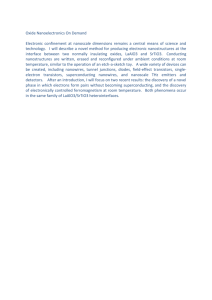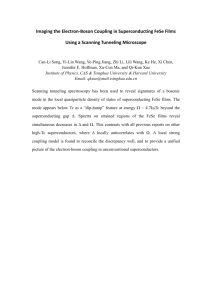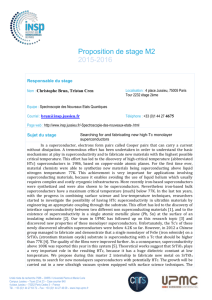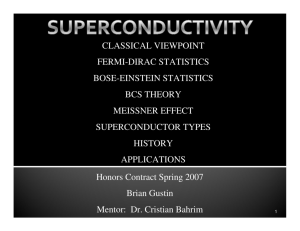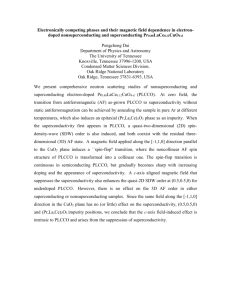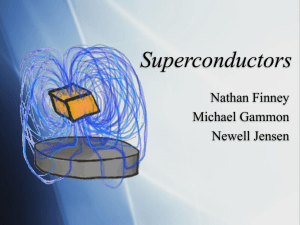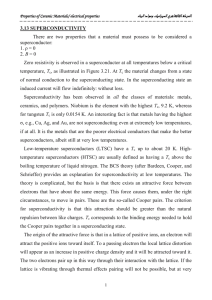7. Progress assessment
advertisement
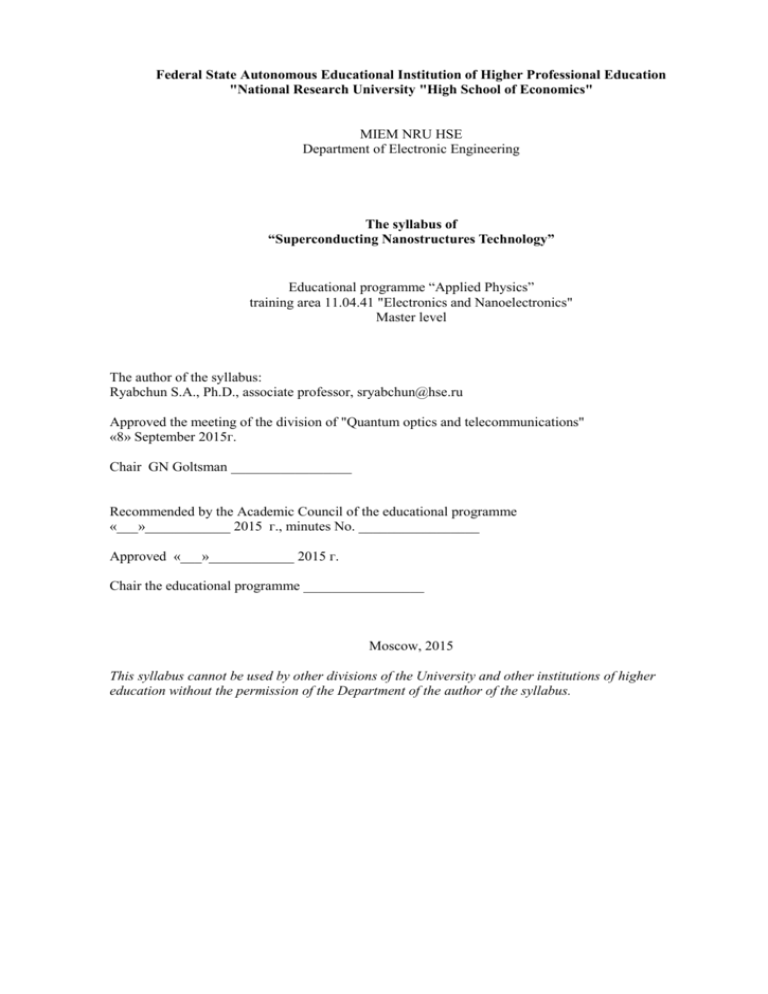
Federal State Autonomous Educational Institution of Higher Professional Education "National Research University "High School of Economics" MIEM NRU HSE Department of Electronic Engineering The syllabus of “Superconducting Nanostructures Technology” Educational programme “Applied Physics” training area 11.04.41 "Electronics and Nanoelectronics" Master level The author of the syllabus: Ryabchun S.A., Ph.D., associate professor, sryabchun@hse.ru Approved the meeting of the division of "Quantum optics and telecommunications" «8» September 2015г. Chair GN Goltsman _________________ Recommended by the Academic Council of the educational programme «___»____________ 2015 г., minutes No. _________________ Approved «___»____________ 2015 г. Chair the educational programme _________________ Moscow, 2015 This syllabus cannot be used by other divisions of the University and other institutions of higher education without the permission of the Department of the author of the syllabus. 1. Course Description a. Title: Superconducting Nanostructures Technology b. Pre-requisites: undergraduate courses in electrodynamics, quantum mechanics and statistical mechanics c. Course type: compulsory d. Abstract: The course starts with a brief overview of the properties of superconducting materials and then proceeds from the simplest phenomenological London theory to the Ginzburg-Landau theory and the Bardeen-Cooper-Schrieffer theory. This is followed by the discussion of the Josephson effects, vortex states, some key aspects of nonequilibrium superconductivity and applications of superconductors as radiation sensors. The rest of the course is dedicated to methods of fabricating superconducting nanostructures. 2. Learning Objectives: familiarity with the basic concepts of classical supeconductivity and applications of superconducting nano-structures as radiation sensors 3. Learning Outcomes: by the end of the course, the students will have formed a coherent picture of the phenomenon of superconductivity and its theories, and will also be able to make simple estimations of various characteristics of superconducting nano-structures for application as radiation sensors. 4. The course is aimed at forming the following competences: SC-3 – capability of independent development of new research methods, changing scientific and production profile of the personal activities and continuing professional development throughout the period of professional activity; SK-6 – capability of analysing, verifying, assessing the completeness of information in the course of professional activity and, if necessary, obtaining and synthesising missing information, and working in conditions of uncertainty; NI-1 - collecting, processing, analysis and systematization of scientific and technical information relating to the study, the choice of methods and means of solving the problem; NI-2 - development of techniques, research and measurement parameters, and characteristics of materials and electronic products, analysis of their results; NI-3 - development of physical and mathematical models, computer simulation of physical processes, devices, circuits and devices related to the professional field; NI-4 - preparation of reviews and reports about ongoing studies; SC-5 - definition of goals and tasks of designing electronic devices, circuits and devices of different functionality, preparation of technical specifications for the implementation of construction work; SC-6 - design of devices, instruments and systems of electronic equipment taking account of the specified requirements; PC-7 - development of design documentation in accordance with the methodological and regulatory requirements; I-13 - improvement of the existing creative methods of solving professional problems; EK-18 - conducting independent research in order to improve personal activities. 5. Place of the course in the curriculum The course “Superconducting Nanostructures Technology” is taken by MSc students of the programme “Applied physics” (training area 11.04.04. “Electronics and nanoelectronincs) and is given by the Division of Quantum Optics and Telecommunication of “Scontel”. The course “Superconducting Nanostructures Technology” is a variable part of the educational program and the core curriculum is offered to students in the first and second modules of the second year of study. Duration of the course is 216 hours (within 2 modules). Of these 60 hours are of classroom training, including 23 hours of lectures and 37 hours of practical training. In addition, 156 hours course are given to students for homework. The students’ progress is assessed by homework in the first module. The exam is held at the end of the second module. Prerequisites for the course are undergraduate courses of "Physics", "Mathematics", and "Quantum Mechanics". 6. Syllabus Module 1 Lectures – 16 hours. Practical classes – 16 hours. Homework – 80 hours. Progress assessment – practical classes C1., homework D1. No. 1 2 3 4 Topic Introduction London theory Ginzburg-Landau theory Type-2 superconductors Total Hours, total 14 28 28 42 112 Lectures 2 4 4 6 16 Classwork Practical classes 2 4 4 6 16 Homework 10 20 20 30 80 Module 2 Lectures – 14 hours. Practical classes – 14 hours. Homework – 76 hours. Progress assessment – practical classes С1. Final assessment – examination. No. 1 2 3 Topic BCS theory Josephson effects Non-equilibrium effects Total Hours, total 28 28 48 104 Lectures 4 4 6 14 Classwork Practical classes 4 4 6 14 Homework 20 20 36 76 7. Progress assessment Module 1 The score of the module is a weighted sum of the score of the practical classes С1 and the score of the homework D1: H1 = 0.2×C1 + 0.7×D1 . (1) Module 2 The score of the module is equal to the score of the practical classes: H2 = C2 . (2) In (1) and (2) Сn is the total score of practical classes (n is the module number) calculated as the mean arithmetic (rounded to an integer) of the score of each practical class Ci in a given module : Cn 1 N N С i 1 i where N is the number of practical classes in a given module. The assessment of students’ performance is based on the ten-point system. Final assessment is by oral examination at the end of Module 2. The mark is based on the ten-point system 8. Final score The final score is weighted sum of the total score (H) and the examination score (Э): P = 0.5×H + 0.5×Э, where the total score (Н) is Н= (Н1+H2 )/2 . Both H and Э are based on the ten-point system. 9. Course Plan ◦ Overview of experiments: perfect conductivity, perfect diamagnetism, persistent currents, the Josephson effects, the isotope effect, the discontinuity in the specific heat, the energy gap. ◦ The London theory of superconductivity: the London equations, simple theory of the Meissner effect, Pippard and London superconductors, complex conductivity, the kinetic inductance. ◦ The Ginzburg-Landau (GL) theory: second-order phase transitions, the order parameter, the GL equations, the coherence length, the proximity effect, the critical magnetic field and the critical current, Josephson effects, type-I and type-II superconductors, flux quantisation, energy of a single vortex, interaction between the vortices, the resistive state. ◦ The Bardeen-Cooper-Schrieffer (BCS) theory: electron-phonon interaction, effective electron attraction, Cooper pairs, the energy gap, the Meissner effect from the microscopi point of view, tunnel junctions, Josephson effect from the microscopic point of view, relation of the BCS and GL theories. ◦ Applications: hot-electron effect in superconductors, superconducting bolometers, photon counters, fabrication techniques. 10. Reading List a. Required: ◦ V.V. Schmidt, The Physics of superconductors: introduction to fundamentals and applications, Springer Verlag, Berlin, Heidelberg, 1997. b. Optional: ◦ M. Tinkham, Introduction to superconductivity, 2nd edition, Mc-Graw Hill Inc., 1996. ◦ D.R. Tilley, J, Tilley, Superconductivity and superfludity, 3rd edition, Institute of Physics Publishing, 1990. 11. Methods of Instruction: lectures and problem-solution sessions 12. Special Equipment and Software Support (if required): not required Author: Sergey Ryabchun



